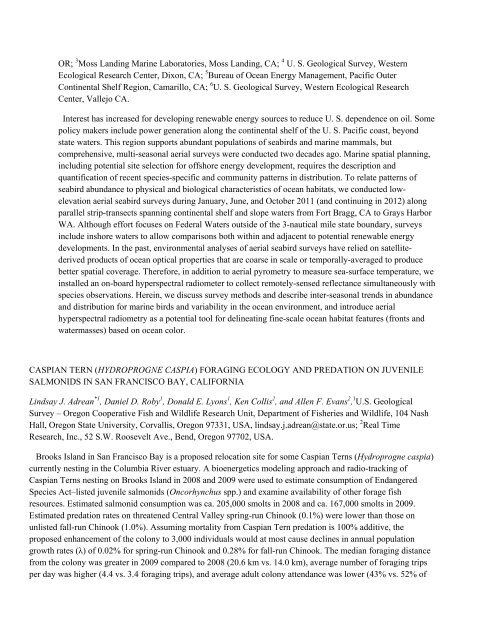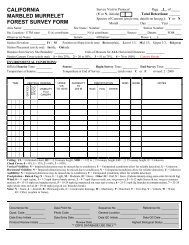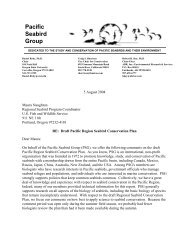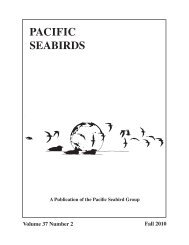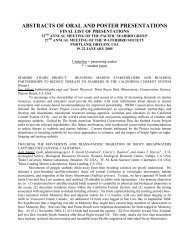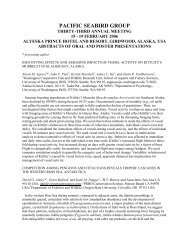PSG 2012 Hawaii abstracts - Pacific Seabird Group
PSG 2012 Hawaii abstracts - Pacific Seabird Group
PSG 2012 Hawaii abstracts - Pacific Seabird Group
Create successful ePaper yourself
Turn your PDF publications into a flip-book with our unique Google optimized e-Paper software.
OR; 3 Moss Landing Marine Laboratories, Moss Landing, CA; 4 U. S. Geological Survey, Western<br />
Ecological Research Center, Dixon, CA; 5 Bureau of Ocean Energy Management, <strong>Pacific</strong> Outer<br />
Continental Shelf Region, Camarillo, CA; 6 U. S. Geological Survey, Western Ecological Research<br />
Center, Vallejo CA.<br />
Interest has increased for developing renewable energy sources to reduce U. S. dependence on oil. Some<br />
policy makers include power generation along the continental shelf of the U. S. <strong>Pacific</strong> coast, beyond<br />
state waters. This region supports abundant populations of seabirds and marine mammals, but<br />
comprehensive, multi-seasonal aerial surveys were conducted two decades ago. Marine spatial planning,<br />
including potential site selection for offshore energy development, requires the description and<br />
quantification of recent species-specific and community patterns in distribution. To relate patterns of<br />
seabird abundance to physical and biological characteristics of ocean habitats, we conducted lowelevation<br />
aerial seabird surveys during January, June, and October 2011 (and continuing in <strong>2012</strong>) along<br />
parallel strip-transects spanning continental shelf and slope waters from Fort Bragg, CA to Grays Harbor<br />
WA. Although effort focuses on Federal Waters outside of the 3-nautical mile state boundary, surveys<br />
include inshore waters to allow comparisons both within and adjacent to potential renewable energy<br />
developments. In the past, environmental analyses of aerial seabird surveys have relied on satellitederived<br />
products of ocean optical properties that are coarse in scale or temporally-averaged to produce<br />
better spatial coverage. Therefore, in addition to aerial pyrometry to measure sea-surface temperature, we<br />
installed an on-board hyperspectral radiometer to collect remotely-sensed reflectance simultaneously with<br />
species observations. Herein, we discuss survey methods and describe inter-seasonal trends in abundance<br />
and distribution for marine birds and variability in the ocean environment, and introduce aerial<br />
hyperspectral radiometry as a potential tool for delineating fine-scale ocean habitat features (fronts and<br />
watermasses) based on ocean color.<br />
CASPIAN TERN (HYDROPROGNE CASPIA) FORAGING ECOLOGY AND PREDATION ON JUVENILE<br />
SALMONIDS IN SAN FRANCISCO BAY, CALIFORNIA<br />
Lindsay J. Adrean *1 , Daniel D. Roby 1 , Donald E. Lyons 1 , Ken Collis 2 , and Allen F. Evans 2 , 1 U.S. Geological<br />
Survey – Oregon Cooperative Fish and Wildlife Research Unit, Department of Fisheries and Wildlife, 104 Nash<br />
Hall, Oregon State University, Corvallis, Oregon 97331, USA, lindsay.j.adrean@state.or.us; 2 Real Time<br />
Research, Inc., 52 S.W. Roosevelt Ave., Bend, Oregon 97702, USA.<br />
Brooks Island in San Francisco Bay is a proposed relocation site for some Caspian Terns (Hydroprogne caspia)<br />
currently nesting in the Columbia River estuary. A bioenergetics modeling approach and radio-tracking of<br />
Caspian Terns nesting on Brooks Island in 2008 and 2009 were used to estimate consumption of Endangered<br />
Species Act–listed juvenile salmonids (Oncorhynchus spp.) and examine availability of other forage fish<br />
resources. Estimated salmonid consumption was ca. 205,000 smolts in 2008 and ca. 167,000 smolts in 2009.<br />
Estimated predation rates on threatened Central Valley spring-run Chinook (0.1%) were lower than those on<br />
unlisted fall-run Chinook (1.0%). Assuming mortality from Caspian Tern predation is 100% additive, the<br />
proposed enhancement of the colony to 3,000 individuals would at most cause declines in annual population<br />
growth rates (λ) of 0.02% for spring-run Chinook and 0.28% for fall-run Chinook. The median foraging distance<br />
from the colony was greater in 2009 compared to 2008 (20.6 km vs. 14.0 km), average number of foraging trips<br />
per day was higher (4.4 vs. 3.4 foraging trips), and average adult colony attendance was lower (43% vs. 52% of


